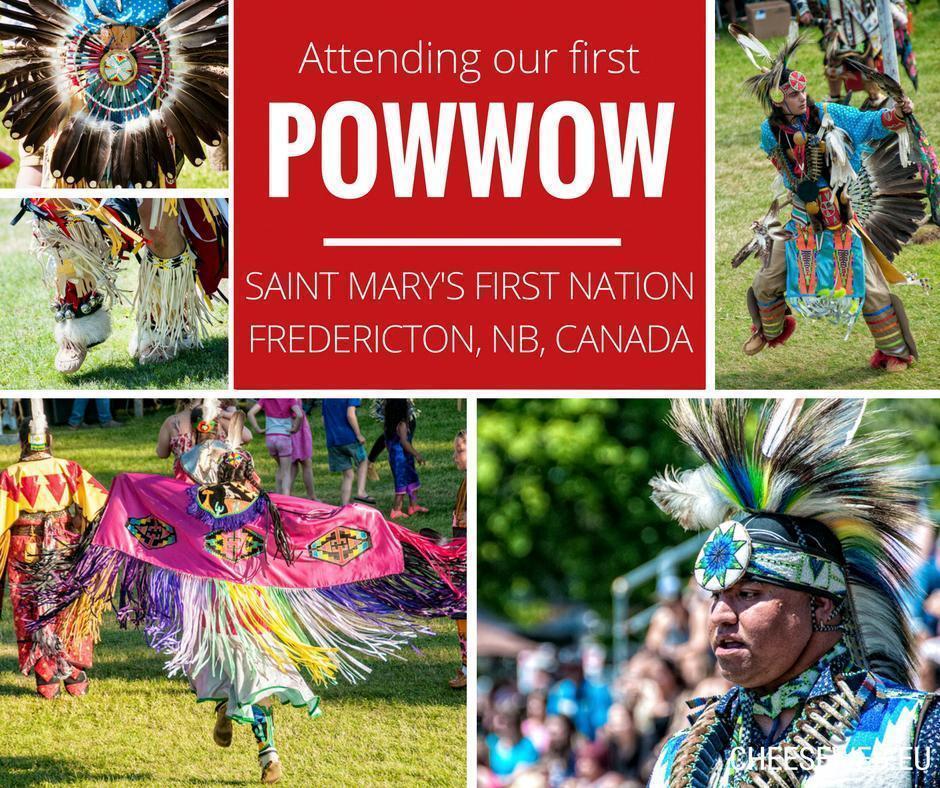
When we first made the decision to return to Canada and spend time exploring New Brunswick, one of our top priorities was to learn more about Canada’s First Nations. For years, we have been travelling around the world to understand other cultures better, but we knew little about those of our native country. When we learned the Saint Mary’s Powwow was open to the public, we decided to take our first tentative steps to learning about First Nations culture.
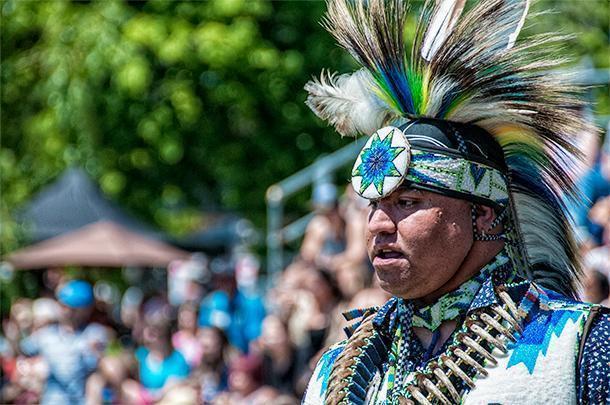
We had no idea what to expect from our first Powwow.
I say tentative because we honestly had no idea what to expect as white, Anglophone, New Brunswickers, attending our first powwow. How would we be received? With Canada’s thoroughly horrific treatment of our First Nations’ people throughout history, would we even be welcome at a celebration of these cultures?
We needn’t have worried. As we made our way onto the festival grounds and throughout the weekend, we were greeted with nothing but smiles, warmth, and openness. But I’m getting ahead of myself.
What is a Powwow?
Of course, we were familiar with the term powwow. We knew it is a gathering of First Nations people and that it involves dancing, colourful outfits, and a spiritual element. Beyond that, we were in the dark.
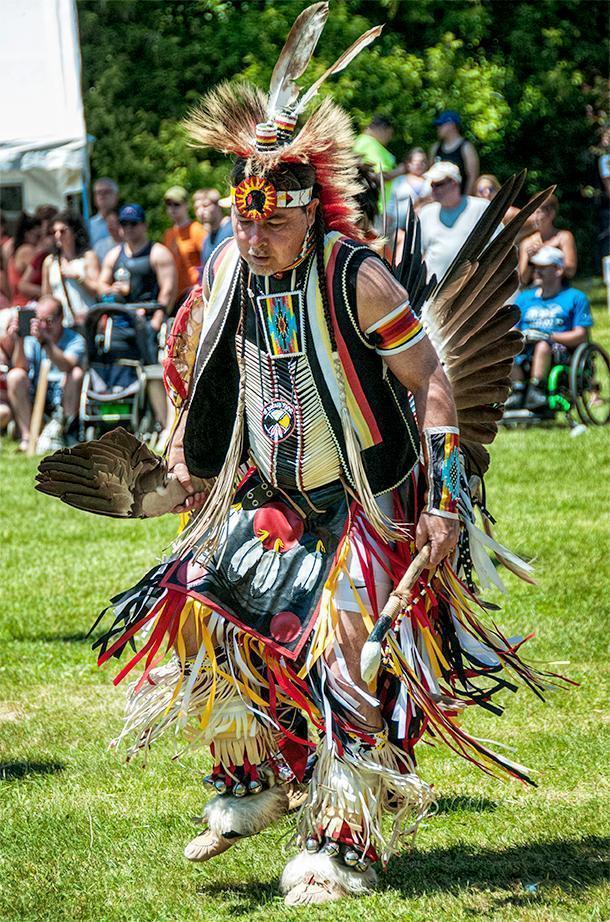
Colourful regalia, dancing, and drums were about all we knew to expect from our first powwow.
What we experienced over our weekend at the powwow was indeed a celebration of First Nations culture. However, it was much more structured than we expected, with opening and closing ceremonies each day. There was almost constant singing and dancing with competitions at all levels, and the drum beat was at the heart of the ceremony.
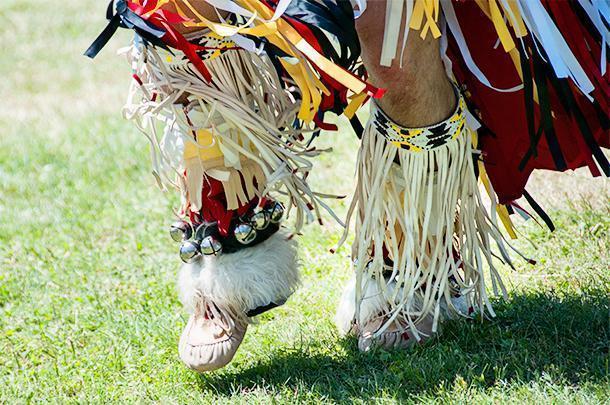
The MCs helped us to understand what was happening at the Saint Mary’s Powwow
The Saint Mary’s Powwow also had two Masters of Ceremonies who not only announced what was happening but explained the significance of the dances, songs, and regalia. These explanations kept us from feeling in the dark and over the course of the weekend we learned a great deal. (Although we still have a very long way to go.)
There was food and handcrafted items for sale and between dancing events the atmosphere was somewhere between a party and a networking event. It was easy to see, many of the dance competitors knew each other from the powwow circuit.
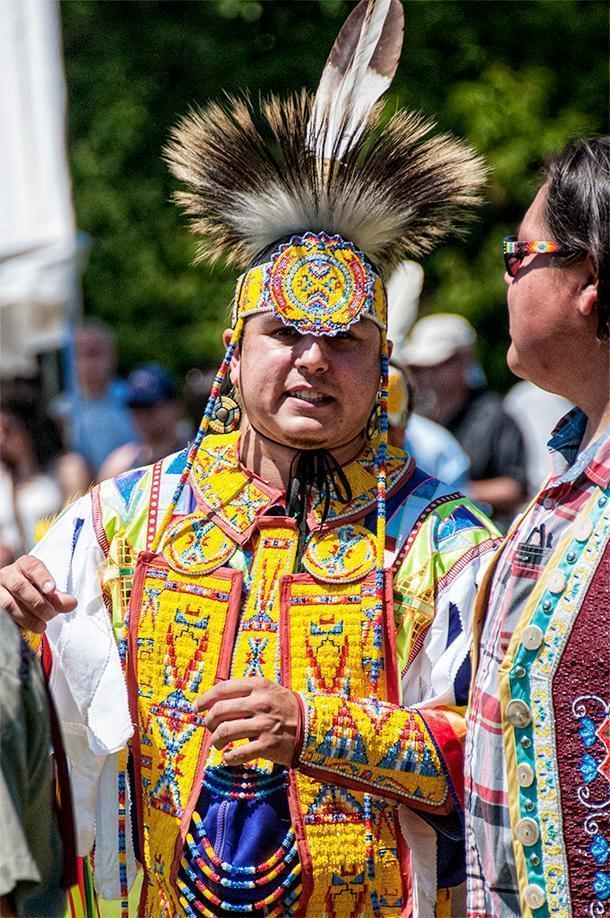
There were plenty of smiles at the Saint Mary’s Powwow, in Fredericton
The Saint Mary’s First Nation
The host of this particular powwow was the Saint Mary’s (Sitansisk) First Nation, a Maliseet (or Wolastoqiyik) Nation located on the northern side of the St. John River in Fredericton. Saint Mary’s is so integrated into Fredericton; it’s easy to miss if you don’t know what you’re looking for.
Saint Mary’s has about 1,850 members, about half of whom live on the reserve. The current chief is a woman, Chief Candice Paul, and, since the 90s, one of the band’s primary mandates has been to create businesses to employ its members. Currently, Saint Mary’s owns and operates the Kchikhusis Commercial Centre, St. Mary’s Supermarket, St. Mary’s Gas Bar, St. Mary’s Smoke Shop, and St. Mary’s Entertainment Centre. Our first encounter with Saint Mary’s was at Wolastoq Wharf, one of our favourite restaurants in Fredericton.
In the map below you can see the Old Reservation Grounds where the powwow is held and some other locations mentioned in this article:
These days, the reserve stretches over 308 hectares, but that wasn’t always the case. In fact, the festival grounds where the powwow is held each year was once the extent of the Saint Mary’s reserve. We looked around as the Master of Ceremonies explained more than 20 families lived on this small pocket of land and were once again amazed and dismayed at what our government has done to its First Nations peoples.
First Nations Dance Styles
Despite occasional sobering reminders about the past and continuing state of First Nations affairs in Canada, the atmosphere at the Saint Mary’s powwow was overwhelmingly celebratory. This was due primarily to the music, dancing, and colourful regalia (which we learned should never be referred to as costumes).
At first, it was difficult for us to distinguish the differences between the dance styles. However, over the course of the weekend, with the help of the informative MCs, we learned a bit about the different dances and their corresponding regalia.
The men’s dances included:
Men’s Traditional – The regalia includes a great deal of beadwork and eagle feathers feature heavily. One dancer had an entire headpiece made of eagle feathers, while several others wore large bustles of eagle feathers.

Men’s Traditional dancer at the Saint Mary’s Powwow in Fredericton, NB

A Men’s Traditional dancer sporting plenty of eagle feathers at the Saint Mary’s Powwow in Fredericton, NB
Grass Dancers – The regalia includes long, multi-coloured fringe that represents grass blowing in the wind.
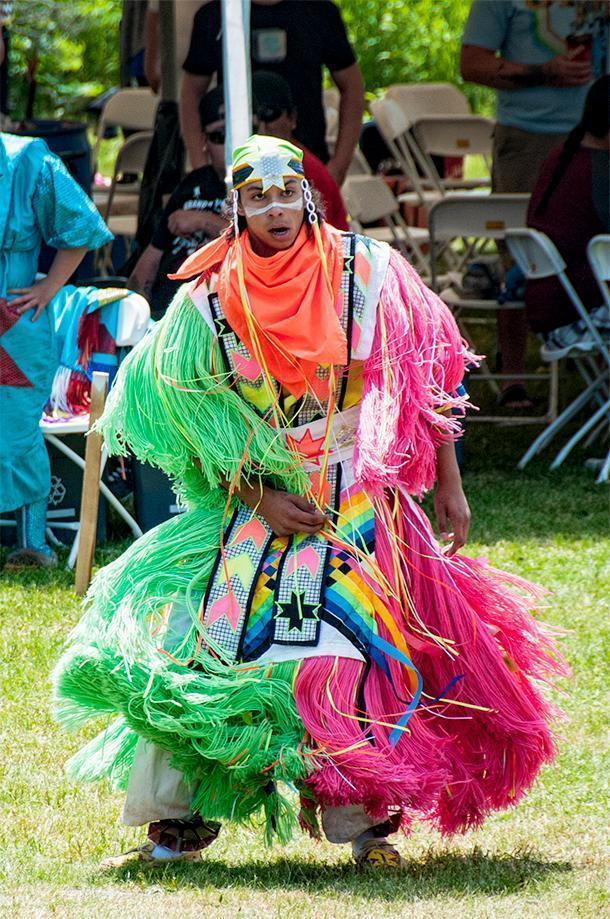
Grass dancer regalia has plenty of billowing fringe.
Fancy Dance – As you would expect, both the dance style and the regalia is the most elaborate. There are plenty of colours, use of non-traditional materials, and the dancing includes jumps and spins.
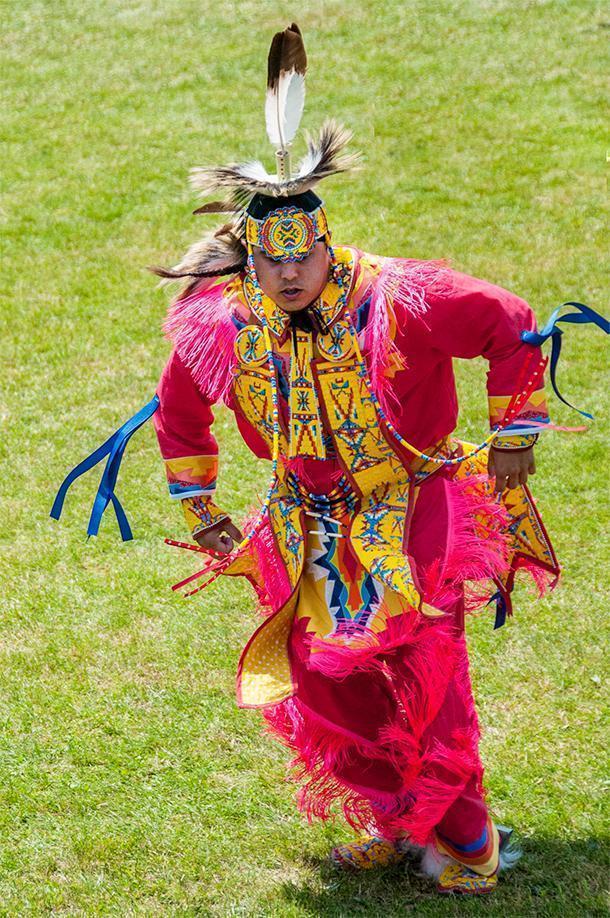
Men’s Fancy Dancers’ regalia is the most colourful and the dance is incredibly high energy.
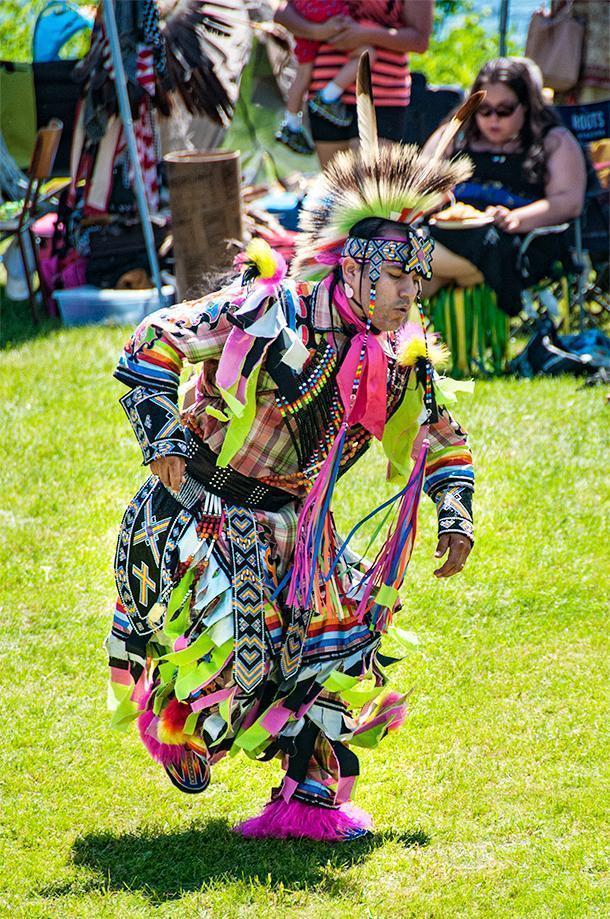
Fancy Dancer at the Saint Mary’s Powwow in Fredericton, NB
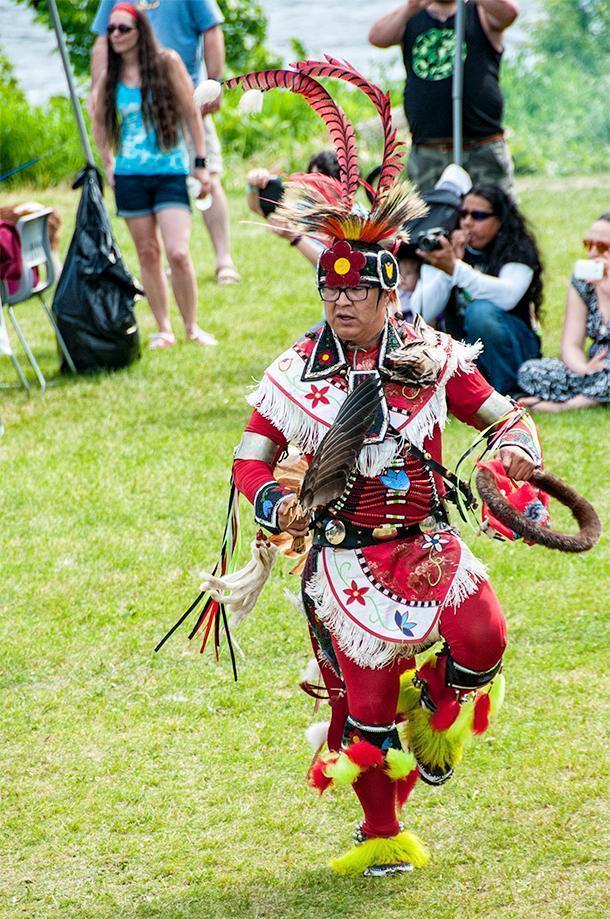
This man was doing a style called the ‘Chicken Dance.’
The women’s dances included:
Women’s traditional – this dance was so stately and dignified the ladies seemed to float. Their regalia is made from traditional materials and often includes stunning beadwork.
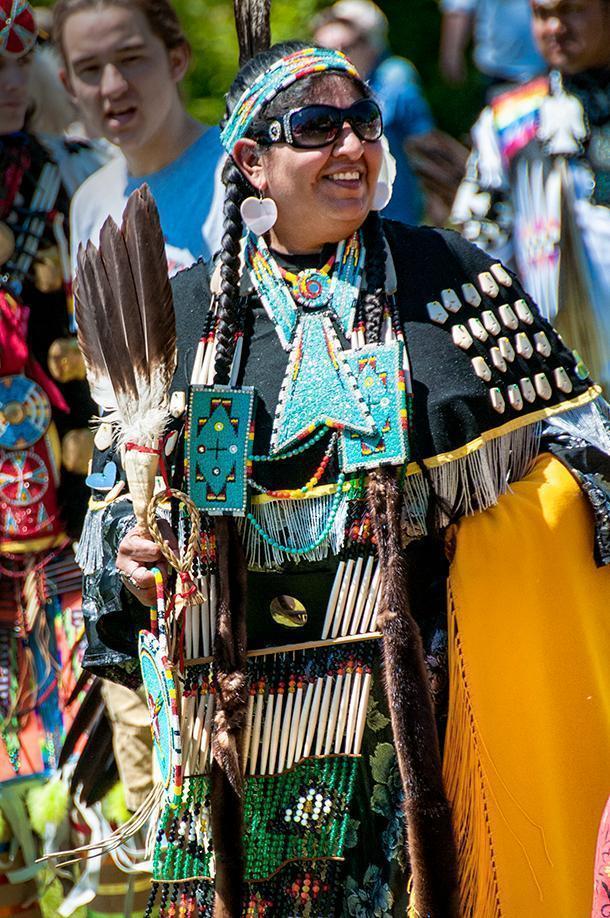
Women’s Traditional costumes include plenty of natural elements and beadwork
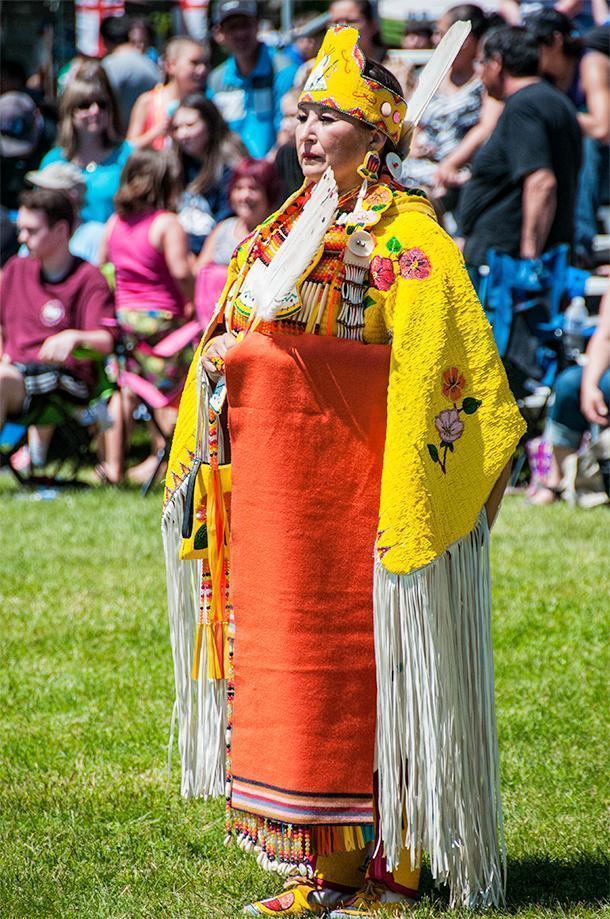
The Women’s Traditional Dance style is deceptively slow and stately.
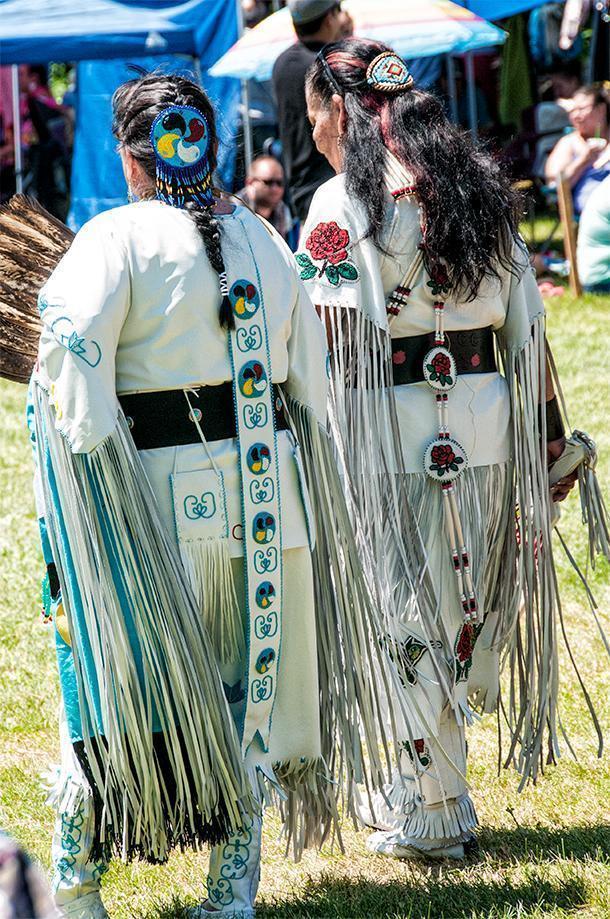
Just look at the beadwork on these Women’s Traditional regalia
Fancy Shawl – As the name suggests, these women dance with colourful shawls often with long fringes. The dancing includes a lot of spinning to show the shawls off to great effect.

The Shawl Dancers were some of the most engaging to watch at the Saint Mary’s Powwow

The twirling colours of the Shawl Dance at the Saint Mary’s Powwow
Jingle Dress – Although the dance is somewhat more subtle, this was one of my favourites. The dresses are decorated with small silver bells that jingle as the dancers move. The dance movements include lots of small jumps and hops to increase the jingling. This is also a very spiritual dance. The jingle dancers were asked to dance at several points during the powwow for people who were sick and in need of prayer. It was incredibly moving.
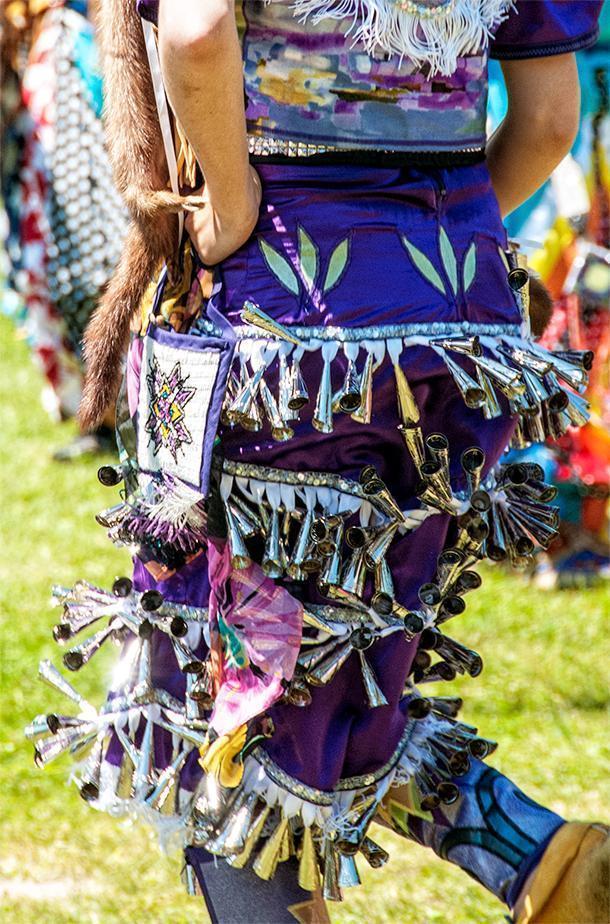
Jingle Dresses are covered with small bells that jingle as the dancers move.
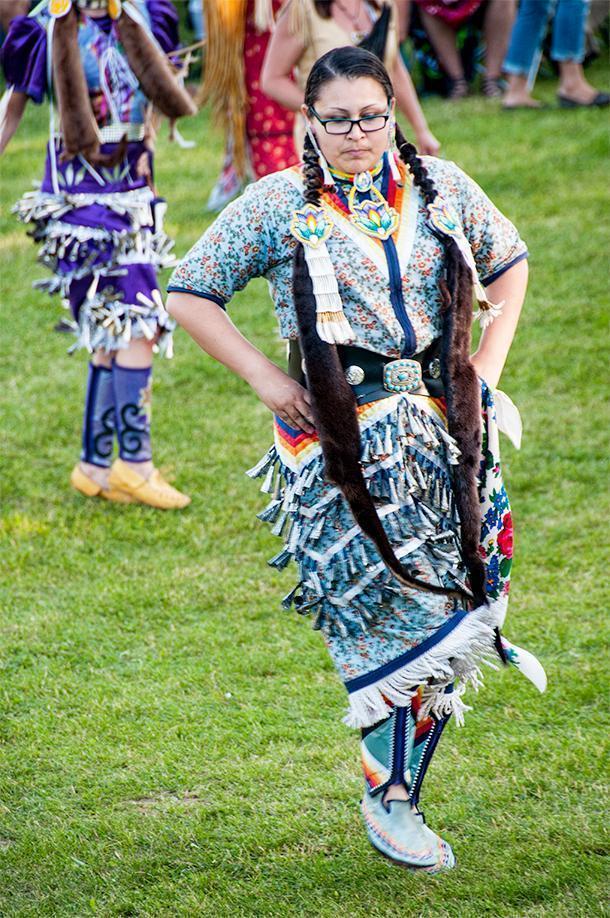
A Jingle Dancer at the Saint Mary’s Powwow

A Jingle Dancer at the Saint Mary’s Powwow
Each day, throughout the weekend, a series of different dances took place. Some were competitions for each style of dance at various age levels, with the finals being held at the end of the day Sunday.
In between competitive dances were ‘Intertribals’ in which any style and level of dance was permitted. During the intertribals, everyone in the audience was invited to come and dance as well.
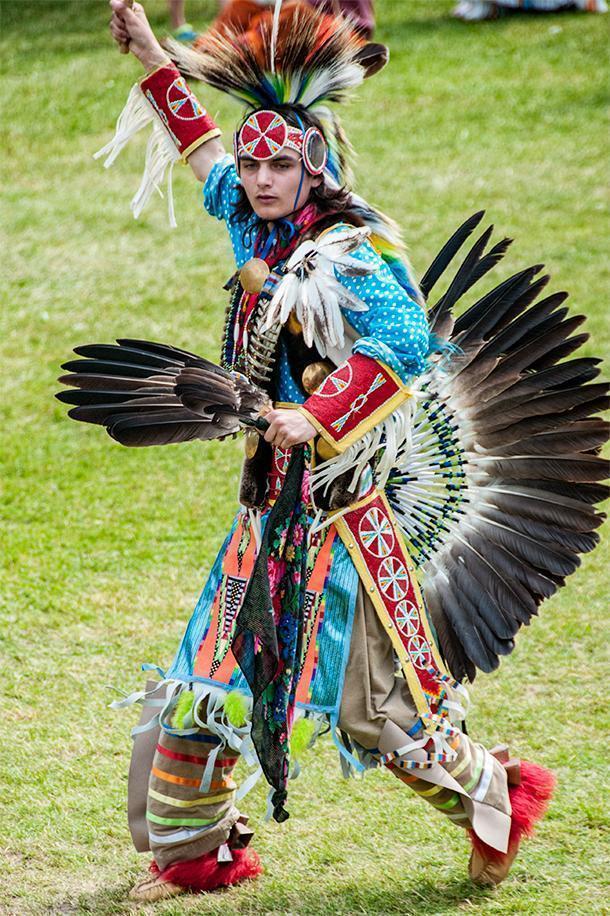
As the weekend progressed the dance competition became more intense.

A competitive dancer at the Saint Mary’s Powwow
There were also special ‘Candy Dances’ for children, ‘Blanket Dances’ to raise money for the dancers and First Nations issues, and a ‘Potato Dance’ with a prize for the couple who could dance with a potato held between them without using their hands the longest.
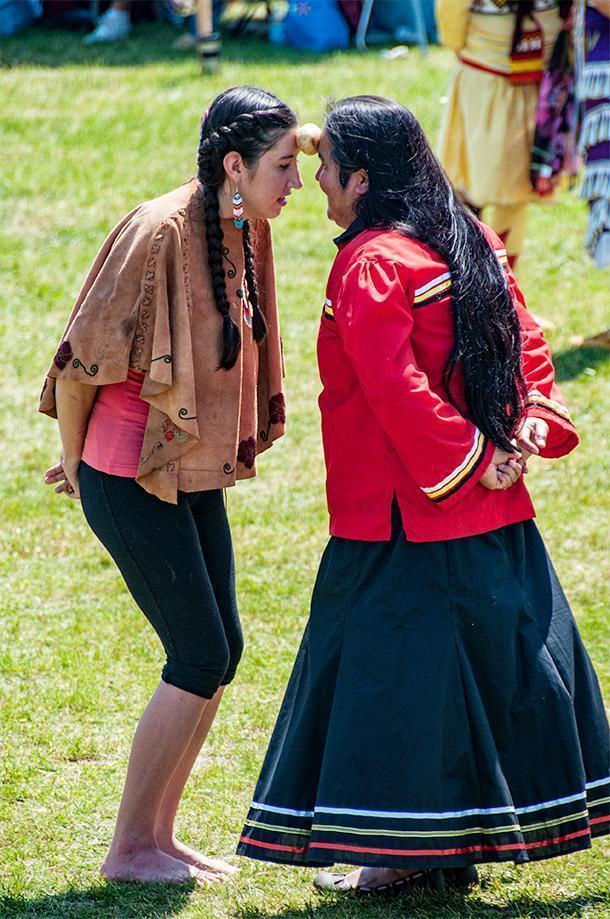
Dances like the Potato Dance broke up the seriousness of the competition.
The dancing was silliness and fun mixed with serious competition and awareness of First Nations’ issues.
Get a feel for the St. Mary’s First Nation Powwow in our short video.
Food at the St. Mary’s Powwow
I’ll be the first to admit, the food offerings at the Saint Mary’s Powwow were pretty limited. There were a few stalls offering grilled sausage and other fast food items. One man was selling homemade beef jerky from a cooler, in both spicy and non-spicy versions. We bought both, and they were excellent.
Our one foodie find of the weekend was the ‘Indian Pizza.’ (Please don’t send me hate mail, I didn’t name it.) It is essentially traditional bannock, a fried flatbread, with pizza-style toppings. We tried it from two different sellers and were hooked.
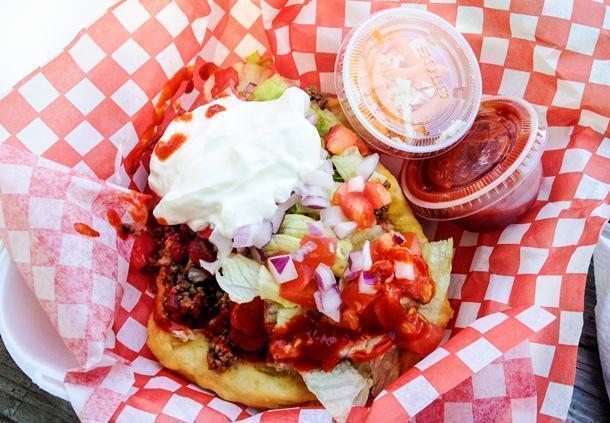
Our first taste of ‘Indian Pizza’ at the Saint Mary’s Powwow.

A variation of ‘Indian Pizza’
If you’re looking for a more upscale dining experience, the Saint Mary’s owned Wolastoq Warf restaurant is right across the street from the festival grounds.
Where we stayed for the Saint Mary’s Powwow
For this visit to the capital, we stayed at the Delta Fredericton Hotel by Marriott. One of the biggest advantages to staying at the Delta is its location on the south bank of the St. John River. The view from our room was gorgeous, as was our evening on the hotel’s terrace watching the sun set over the river.

A lovely night at the Delta Fredericton Hotel
The Delta is set a bit outside of Fredericton’s downtown core, but still within easy walking distance of the city’s attractions. The advantage is plenty of free parking. The other big advantage – the Delta is just a few minutes walk from the Fredericton Cultural Market!
The Delta also has indoor and outdoor pools, a spa, gym, boat launch, [Catch] Urban Grill fine-dining restaurant, and the Dip Pool Bar. We had an excellent night’s sleep in our spacious room-with-a-view.
A few other great accommodation options in Fredericton are the Crowne Plaza Hotel and the gorgeous Quartermain House B&B.
What Surprised Us about the Saint Mary’s Powwow
Because we had no idea what to expect from the Saint Mary’s Powwow, everything was a surprise; from the dramatic regalia and competitive dancing to the festival-like atmosphere. However, there were two things we found particularly surprising.
The first surprise was just how far people travelled to attend the powwow. Attendees came not just from First Nations around New Brunswick, but from all over the Maritime Provinces, the rest of Canada, and even the United States. There were contestants from as far away as South Dakota and Western Canada.
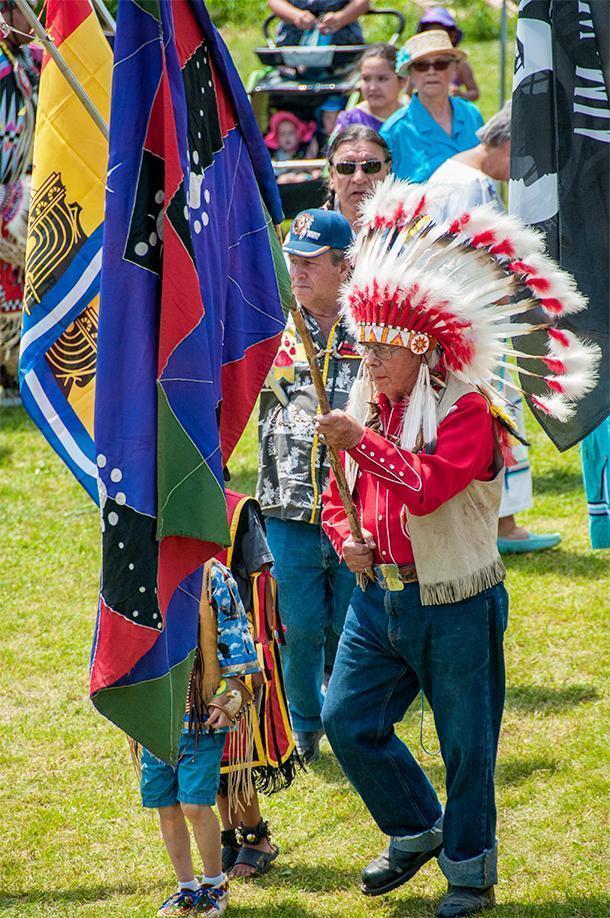
Participants travelled long distances to attend the Saint Mary’s Powwow
The dance competition is taken seriously, and some of the dancers spend the summer travelling from powwow to powwow to compete. There are cash prizes for the top dancers, although they can’t possibly cover the cost of travel and the elaborate regalia.
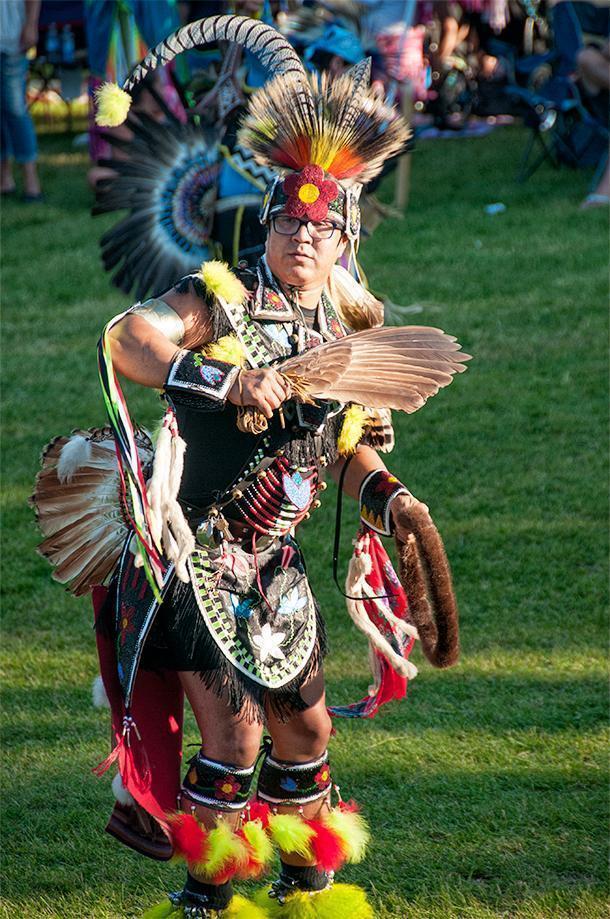
We can’t imagine the cost of some of the intricate regalia and many of the competitive dancers had more than one.
Our second, and most notable, surprise was just how inclusive the Saint Mary’s Powwow is. Not all powwows are open to the public, but Saint Mary’s is wonderfully welcoming. There were people in the audience from all nationalities, and everyone was encouraged to join in the non-competitive dances.
The flags waving over the powwow grounds represented First Nations from across Canada and the United States, as well as the Canadian, New Brunswick, and Rainbow Pride flags.
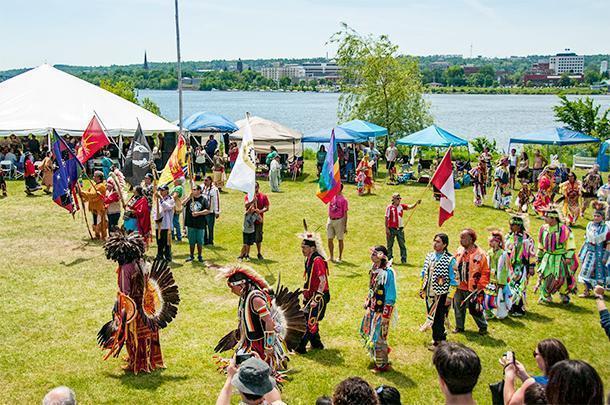
A host of diverse flags wave over the Saint Mary’s First Nation Powwow
The range of ages was just as diverse; from the youngest of babies carried in the dance circle by their parents to proud elders circling the grounds with dignity. It was encouraging to see how many young people, especially teenagers, were participating in the dances when it’s often hard to pry teens away from their mobile devices.
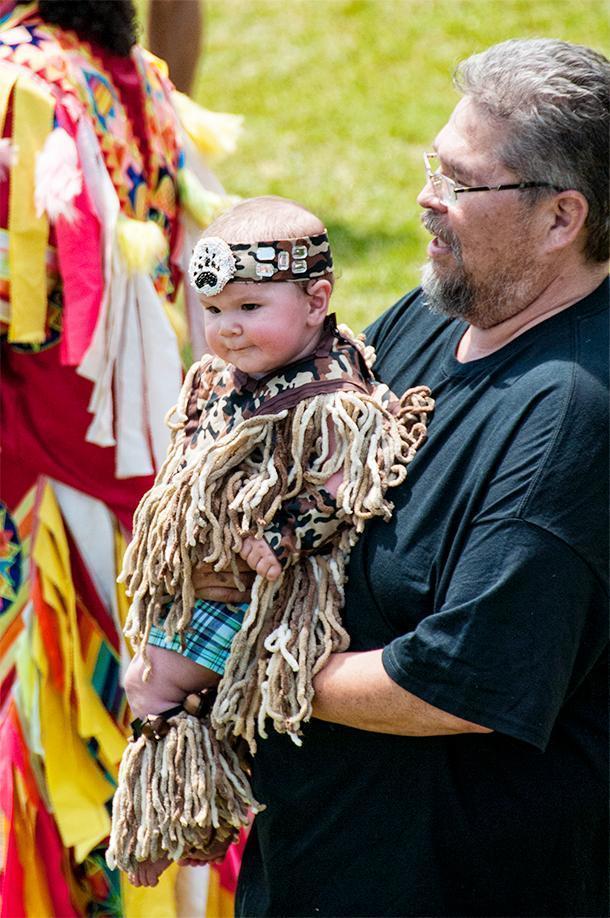
All ages were encouraged to participate in the Intertribal dances
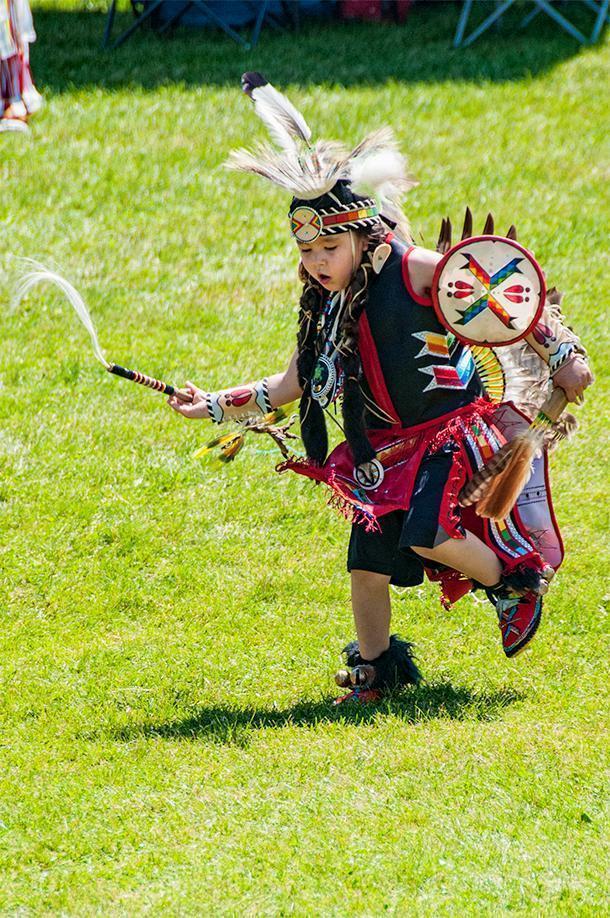
One of the youngest competitors at the Powwow
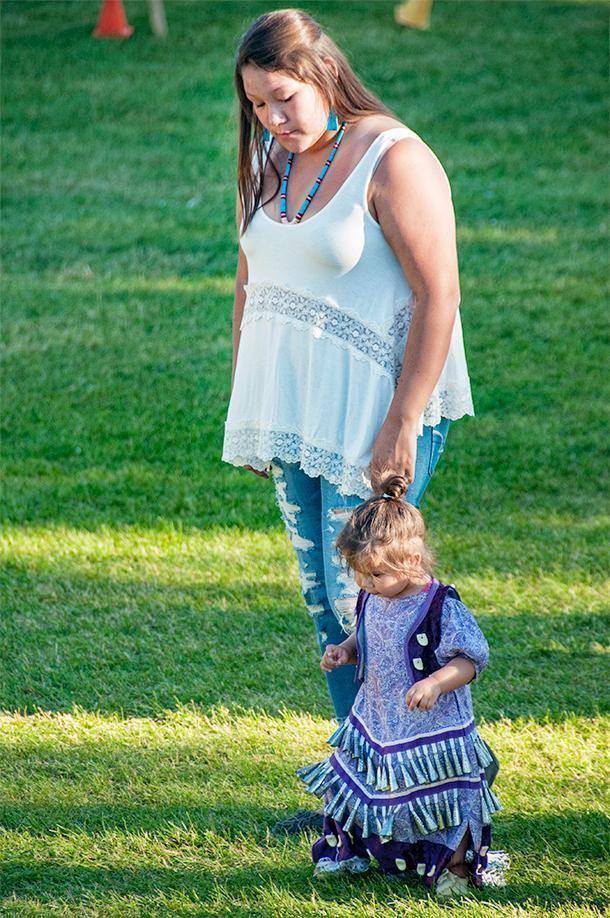
Young dancers often walked the circle with their family members
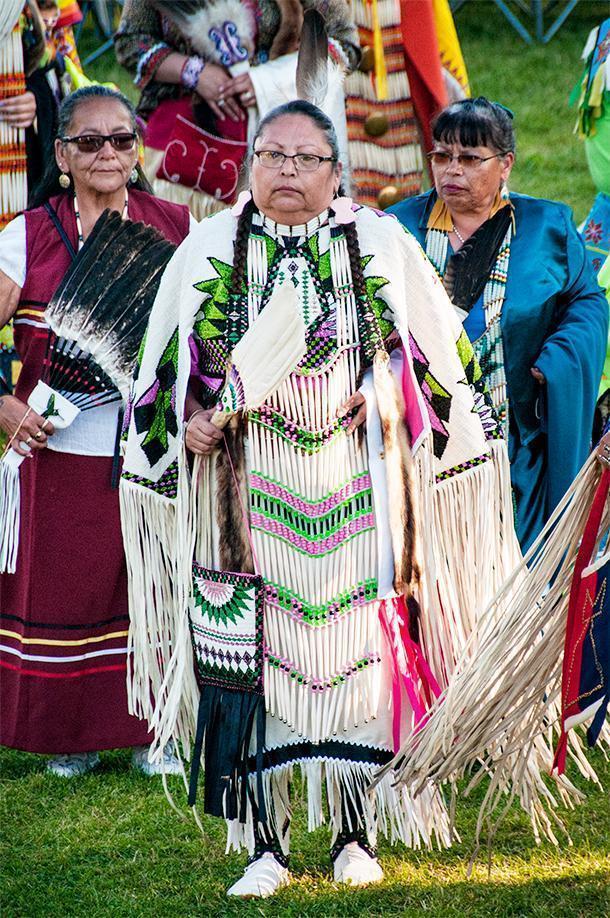
Many elders made the long journey to attend the Saint Mary’s Powwow
Throughout the weekend we felt completely included. People chatted with us, asked where we were from, and answered our questions without hesitation.
While I can’t say I understood every aspect of the powwow (that would take a lifetime), I felt completely caught up in its spirit of celebration. There were moments so powerful I had tears in my eyes, and I left feeling the desire to be part of something bigger.
Attending my first powwow made me realise how much I have to learn about the nations within my own country. What I discovered at Saint Mary’s is the merest tip of the iceberg of these rich cultures.
Like countries around the world, Canada can never make up for the atrocities we’ve heaped (and continue to heap) on our First Nations people. Perhaps if we focused more time on learning about these cultures right here in our own country, we’d be more inclined to preserve and protect them.
[NOTE] I had an impossible time choosing the photos to illustrate this article because I took SO many. If you’d like to see more, check out my Saint Mary’s First Nation’s Powwow photo gallery.
We’d like to thank Fredericton Tourism for inviting us to discover the Saint Mary’s Powwow and hosting our stay for the weekend. As always, all opinions remain our own.
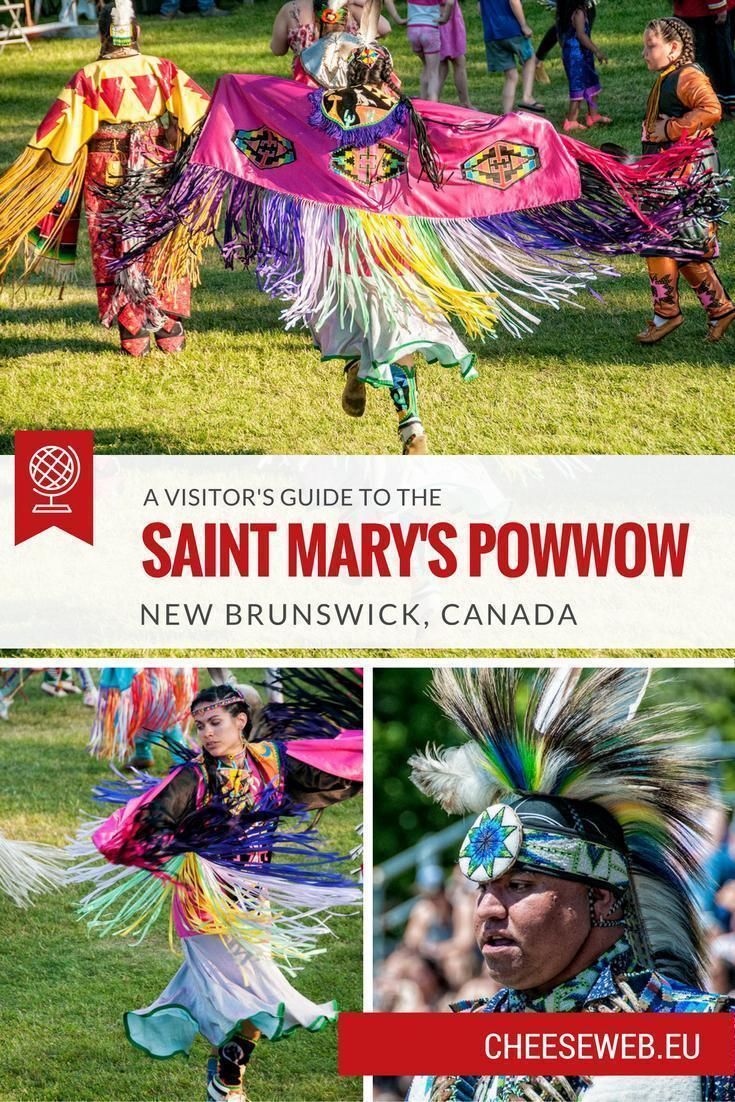
Like this article? Save it to Pinterest!
- The Ultimate List of Castle Hotels in Belgium - June 10, 2019
- The Ultimate Guide to the Best Things to Do in Normandy, France - February 5, 2019
- The Ultimate Guide to the Best Restaurants in Brussels, Belgium - January 11, 2019
